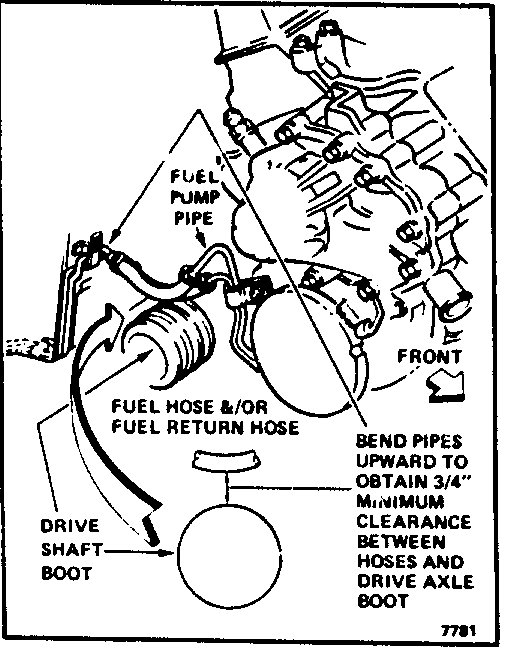CAMPAIGN: FUEL HOSE TO DRIVE AXLE BOOT INTERFERENCE

CONDITION INVOLVED
General Motors has determined that a defect which relates to motor vehicle safety exists in some 1980 Phoenix models equipped with a V-6 engine.
On these vehicles, the fuel hoses may be incorrectly positioned and come in contact with the right front drive axle boot while the vehicle is being driven. The rotating boot, after a period of time, could rub a hole in the fuel hose resulting in fuel leakage and the potential of a fire in the engine compartment.
VEHICLES INVOLVED
Involved are some 1980 Phoenix models equipped with a V-6 engine produced at the Tarrytown (T) assembly plant from the start of production through the following V.I. Number:
PLANT BEGINNING V.I.N. UP TO ----- ----------------- ------ 1980 Tarrytown sop 2Y37SATIO6222
OWNER NOTIFICATION
Owner notification will not be necessary, as all involved vehicles will be corrected prior to announcement and invoice release.
DEALER ACTION
Dealers are to inspect all cars listed on the printout furnished. A minimum of 3/4" clearance must exist between the fuel hoses and the right front drive axle boot. If necessary, provide the required clearance by reforming the pipes upward as outlined in the service procedure.
DEALER CAMPAIGN RESPONSIBILITY
Dealers are to perform this product campaign on all affected vehicles in new car stock prior to vehicle sale.
SERVICE PROCEDURE
1. Hoist car. Hoist should be positioned as far forward as possible to provide maximum access to the right front drive axle area.
2. Refer to illustration shown on the reverse side. Inspect fuel hoses for abrasion damage and replace any hose which is damaged.
3. Make sure that both fuel pipes are retained in the clip attached to the cowl panel.
4. With pipes properly retained in clip, check the clearance between the hoses and the drive axle boot. There should be a minimum of 3/4" clearance.
5. If clearance is less than 3/4", reform the pipes by pushing upward on pipes in area where hoses are attached. (Refer to illustration).
6. Make sure pipes are still retained in clip. If clip has one loose end, bend loose end upward and rearward to properly retain pipes.
7. Lower car.
8. Open hood.
9. Clean the surface of the upper radiator support tie bar where it is readily visible when the vehicle is brought in for periodic servicing by the owner. When surface is clean and dry, apply the attached "Campaign Identificaiton Label 80-C-3".
Notice: Your 6-digit dealer code is to be typed or written in with ball point pen on the Campaign Identification Label.
10. Close hood.
ENCLOSED WITH YOUR CERTIFIED MAIL COPY OF THIS LETTER ARE THE FOLLOWING:
A list of those vehicles involved which our records indicate have been shipped to your dealership is attached. Advise the zone if any of the vehicles appearing on the attached list are not in your area.
If a vehicle has been transferred to another location, please forward details of the transfer to your Pontiac zone office.
RECORDING COMPLETION
Completion will be recorded from properly completed and paid Warranty Claims.
Additional labels are available from your zone office service department.
DEALERS SHOULD STILL SUBMIT WARRANTY CLAIMS FOR CREDIT IN THEIR NORMAL MANNER WHEN THEY PERFORM THE SERVICE AS FOLLOWS:
(Notice: a completed warranty claim is to be kept as apermanent record of completion.)
WARRANTY CREDIT
A separate repair order must be used for each VIN.
(LABOR)
The new labor operation is assigned specifically for this campaign.
LABOR TROUBLE DESCRIPTION OPERATION CODE TIME ------------ --------- ---- ----
Inspection/correction L006530 96 0.3 hour V-6 Fuel Hose Routing
TROUBLE CODE 96 MUST BE USED WITH THIS LABOR OPERATION.
Dealers will automatically receive 0.1 hours credit for dealer administrative detail associated with this campaign.
(CREDITING)
Dealers will be credited via Warranty Document or Terminal Transmission, whichever is their normal method of submission for payment. Claims should be Claim Type 01, containing all information required for a regular claim, and should list the appropriate labor operation as outlined above.
Repairs submitted for vehicles not involved in the campaign will not be paid.

General Motors bulletins are intended for use by professional technicians, not a "do-it-yourselfer". They are written to inform those technicians of conditions that may occur on some vehicles, or to provide information that could assist in the proper service of a vehicle. Properly trained technicians have the equipment, tools, safety instructions and know-how to do a job properly and safely. If a condition is described, do not assume that the bulletin applies to your vehicle, or that your vehicle will have that condition. See a General Motors dealer servicing your brand of General Motors vehicle for information on whether your vehicle may benefit from the information.
